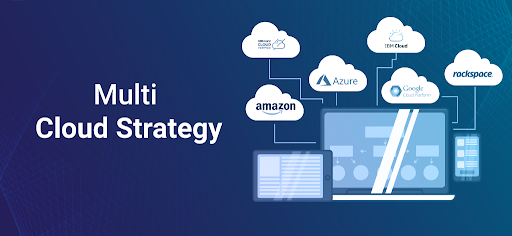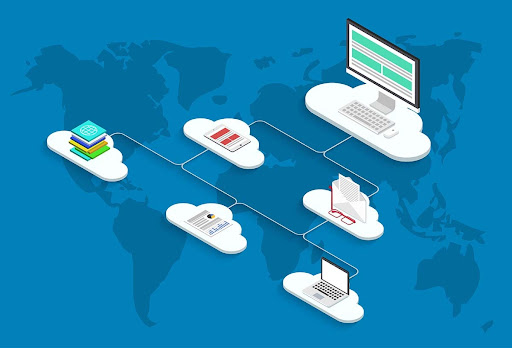Holding on to a cloud provider that no longer satisfies your growing and evolving infrastructure is a pointless exercise.
One way to avoid getting stuck is opting for a multi-cloud approach to cloud hosting. Organizations need to factor in quality, costs, features, availability, and requirements before choosing a suitable multi-cloud solution that offers the best services and meets their ever-increasing infrastructure needs.
All of the above factors together make up a multi-cloud environment, using more than one cloud platform or service to host IT infrastructure.
What is multi-cloud?
Multi-cloud is a strategy in which an organization uses multiple cloud computing services to complete tasks. This ensures that no organization completely relies on a single cloud service provider to operate and function. Using multi-cloud, organizations get the best of many worlds by choosing the most appropriate services from each provider.
What is a multi-cloud strategy?
If you want to use a multi-cloud architecture to better serve your business needs, it cannot be arbitrary or unplanned. You need to draw up a specific plan in which it’s precisely clear what type of cloud services and vendors to go for. This plan is a multi-cloud strategy that helps organizations understand how it’ll meet their IT needs before implementing it.

A multi-cloud strategy ideally includes the different kinds of cloud services an organization uses and how this cloud mix makes business operations and IT expenses leaner and efficient.
Benefits of a multi-cloud approach
There are several reasons why organizations are increasingly shifting toward a multi-cloud approach. Some of them are listed below.
1. Avoid vendor lock-in
Organizations that choose a single cloud vendor to meet all of their IT requirements are likely to face vendor lock-in at some point. Vendor lock-in is a situation where an organization’s applications and functionalities are tailored to the features and capabilities of a single cloud provider.
It’s costly, time-consuming, and arduous to transfer data and applications to other cloud service providers. A multi-cloud approach, on the other hand, provides flexibility and agility, enabling a comparatively unrestricted movement of applications from one cloud platform to another.
2. Optimize cloud workloads and expenses
Each public cloud provider attempts to make its service stand out from the rest and, therefore, offers its customers different features and capabilities. For this reason, no cloud service can claim a one-for-all solution that addresses all of an organization’s requirements.
With a multi-cloud approach, an organization can host its applications on a cloud platform best suited for overall functionality. This “best of many worlds” approach significantly improves cloud efficiency while reducing IT expenditure.
3. Resolve data gravity problems
Data gravity is the observed characteristic of a large volume of data that is very difficult to migrate. This is exacerbated when an organization only uses one service provider.
Data gravity could force the organization to launch applications and new IT infrastructures on the same platform, even if it’s not the most cost-efficient or ideal option. You can mitigate this problem with a multi-cloud approach together with a cloud-based storage solution by enabling multiple fast connections to a large number of servers.
4. Improve application performance
As application demand increases and usage spreads over a large geographic area, latency inevitably increases. This leads to slower application response times and overall poorer performance.
With a multi-cloud system, an organization can easily choose between different cloud service providers operating in widespread geographic locations. This, in turn, helps avoid latency and facilitates efficient application performance at all times.
5. Prepare for server outages
Most cloud service providers promise unfettered runtime up to and over 99.5%. However, this doesn’t mean that server outages will not occur. Technical failures lead to downtime, which is catastrophic if all of a business’ applications and resources depend on one cloud provider.
This is where multi-cloud comes to the rescue. With a multi-cloud approach, you can transfer the workload of an application or resource to an alternate server if one cloud service fails to ensure continued access for all users.
6. Meet regulatory compliance
Many countries around the world have data compliance norms requiring data localization in terms of storage, handling, and usage. Compliance is often quite tricky, but you can easily and effortlessly comply with these regulations and requirements if you choose a cloud service provider with different operating zones.
Multi-cloud challenges
Although a multi-cloud approach offers organizations a variety of cost-control, efficiency, and management benefits, it’s not particularly easy to avail these benefits.

Organizations looking to switch to a multi-cloud architecture for their IT requirements often face three overarching challenges listed below.
1. Financial
Switching to a multi-cloud system is not an inexpensive affair. Most businesses rack up huge bills by egressing data from one cloud provider to another and from the cost of redeveloping applications to support and thrive on multi-cloud architecture. These costs are further increased by optimizing data storage to work with multiple clouds.
2. Technical
Setting up a multi-cloud infrastructure is a complex process requiring advanced technical expertise, which most organizations don’t have in-house. This, therefore, requires outsourcing the setup to external experts.
Working with large volumes of data and coordinating the use of multiple clouds and their varying functionalities is not a menial task. There are several technical challenges that every organization faces when switching to multi-cloud.
3. Security
If your organization’s data and information are shared with and handled by multiple cloud providers, ensuring data privacy and security becomes a massive challenge. This is made more difficult because different cloud providers may have different security and data privacy policies.
How to choose the right cloud mix and provider
Once you decide to go for multi-cloud, you still don’t know the right cloud mix. A perfect mix is the most efficient and cost-effective combination of features and services from multiple cloud providers.
Choose only highly efficient cloud infrastructure services to set up your multi-cloud. To find the right cloud mix, consider the following three factors.
1. Features and services offered
As explained above, each service provider offers a unique set of cloud features and services. You need to compare and analyze these services before deciding on a suitable combination of cloud providers for your organization.
2. Technical requirements of the organization
Every organization has different IT requirements and expectations. After comparing these requirements with the features and offerings of cloud providers, you can choose the perfect cloud mix.
3. Costs
Finally, an organization needs to ensure that the right cloud mix is also the most cost-efficient. The whole point of multi-cloud is maximizing efficiency. This will be defeated if the combined costs of the various cloud services inflate your IT expenses.
Before you focus on the advantages, consider the disadvantages
Despite the many advantages of multi-cloud, it also comes with a fair share of challenges. To best leverage the offerings, every organization needs to consider the tips and tricks mentioned above when developing a multi-cloud strategy.
If you are looking for an easy-to-use and feature-laden multi-cloud service capable of handling a versatile range of requirements, look no further than Middleware.



